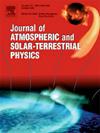Numerical simulation study on high temporal resolution variation characteristics of atmospheric limb infrared radiation under aurora disturbance
IF 1.9
4区 地球科学
Q3 GEOCHEMISTRY & GEOPHYSICS
Journal of Atmospheric and Solar-Terrestrial Physics
Pub Date : 2025-08-23
DOI:10.1016/j.jastp.2025.106614
引用次数: 0
Abstract
Auroral disturbances can significantly enhance atmospheric limb infrared radiance in near space by several orders of magnitude, impacting space-based systems. This study used infrared radiance data from the Sounding of the Atmosphere using Broadband Emission Radiometry (SABER) instrument onboard the Thermosphere-Ionosphere-Mesosphere Energetics and Dynamics (TIMED) satellite during the 2003 “Halloween Storm” to estimate the accuracy of the Strategic High-Altitude Radiance Code (SHARC) model under both quiet and auroral conditions. The average relative error of the SHARC simulations compared to the SABER measurements ranged from 11.8 to 19.4 %, indicating a reliable agreement with the observations. Due to the limited temporal resolution of satellite observations at fixed locations, SHARC was further used to simulate hourly variations in 4.3 and 5.3 μm infrared radiance over high-latitude regions (50–200 km) during the storm. The results showed that auroral disturbances enhanced the 4.3 μm radiance by up to two orders of magnitude, particularly above 130 km during the day and above 110 km at night. The 5.3 μm radiance was also enhanced, with peak increases of about one order of magnitude near 120 km. The study also analyzed the temporal evolution of key excited-state species (NO, CO2, and NO+), identifying their respective roles in infrared enhancement. Finally, the uncertainties in the SHARC simulations and SABER measurements were discussed, confirming the applicability of SHARC under auroral conditions and clarifying the differing enhancement mechanisms of the two bands.
极光扰动下大气边缘红外辐射高时间分辨率变化特征的数值模拟研究
极光扰动可以显著增强近空间的大气翼红外辐射,影响天基系统。本研究利用2003年“万圣节风暴”期间,热层-电离层-中间层能量学与动力学(TIMED)卫星上搭载的宽带发射辐射测量仪(SABER)的大气探测数据,估算了战略高空辐射代码(SHARC)模型在安静和极光条件下的精度。与SABER测量结果相比,SHARC模拟的平均相对误差在11.8%到19.4%之间,表明与观测结果的可靠一致性。由于固定地点卫星观测的时间分辨率有限,我们进一步利用SHARC模拟了风暴期间高纬度地区(50-200公里)4.3和5.3 μm红外辐射的逐时变化。结果表明,极光扰动使4.3 μm辐射增强了两个数量级,特别是在白天130 km以上和夜间110 km以上;5.3 μm辐射强度也有所增强,在120 km附近峰值增加了约一个数量级。研究还分析了关键激发态物种(NO、CO2和NO+)的时间演化,确定了它们在红外增强中的作用。最后,讨论了SHARC模拟和SABER测量的不确定性,证实了SHARC在极光条件下的适用性,并阐明了两个波段的不同增强机制。
本文章由计算机程序翻译,如有差异,请以英文原文为准。
求助全文
约1分钟内获得全文
求助全文
来源期刊

Journal of Atmospheric and Solar-Terrestrial Physics
地学-地球化学与地球物理
CiteScore
4.10
自引率
5.30%
发文量
95
审稿时长
6 months
期刊介绍:
The Journal of Atmospheric and Solar-Terrestrial Physics (JASTP) is an international journal concerned with the inter-disciplinary science of the Earth''s atmospheric and space environment, especially the highly varied and highly variable physical phenomena that occur in this natural laboratory and the processes that couple them.
The journal covers the physical processes operating in the troposphere, stratosphere, mesosphere, thermosphere, ionosphere, magnetosphere, the Sun, interplanetary medium, and heliosphere. Phenomena occurring in other "spheres", solar influences on climate, and supporting laboratory measurements are also considered. The journal deals especially with the coupling between the different regions.
Solar flares, coronal mass ejections, and other energetic events on the Sun create interesting and important perturbations in the near-Earth space environment. The physics of such "space weather" is central to the Journal of Atmospheric and Solar-Terrestrial Physics and the journal welcomes papers that lead in the direction of a predictive understanding of the coupled system. Regarding the upper atmosphere, the subjects of aeronomy, geomagnetism and geoelectricity, auroral phenomena, radio wave propagation, and plasma instabilities, are examples within the broad field of solar-terrestrial physics which emphasise the energy exchange between the solar wind, the magnetospheric and ionospheric plasmas, and the neutral gas. In the lower atmosphere, topics covered range from mesoscale to global scale dynamics, to atmospheric electricity, lightning and its effects, and to anthropogenic changes.
 求助内容:
求助内容: 应助结果提醒方式:
应助结果提醒方式:


